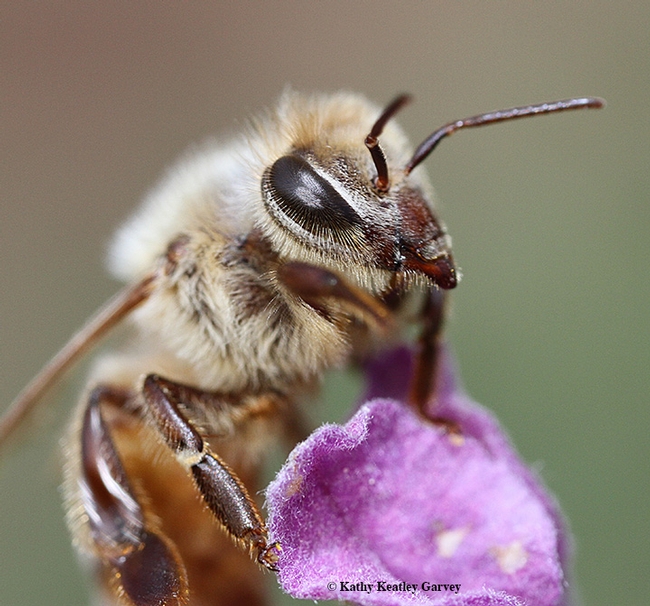- Author: Kathy Keatley Garvey
The things we overlook are the things we should look for.
Take mustard and honey bees.
You've seen mustard thriving in fields, but have you ever considered planting some seeds from a nursery in your garden so honey bees will have something to eat in early spring? (And then, of course, replacing the mustard with other plants so the mustard does not go to seed? The soil also benefits.)
We've been planting mustard now for several years, and it's a joy to watch the bees foraging, flying and gathering pollen and nectar. Sometimes they'll stop in mid-air to clean their tongues.
"The importance of pollen to the health and vigor of the honey bee colony cannot be overstated," writes Norman Gary, emeritus professor of entomology at the University of California, Davis, in his book, Honey Bee Hobbyist: The Care and Keeping of Bees. "Honey bees need a balanced diet. Honey satisfies the bees' carbohydrates requirements, while all of the other nutrients--minerals, proteins, vitamins and fatty substances--are derived from pollen. Nurse bees consume large amounts of pollen, converting it into nutritious secretions that are fed to developing larvae. During an entire year, a typical bee colony gathers and consumes around 72 pounds of pollen."
"Pollen in the plant world is the equivalent of sperm in the animal world," Gary continues. "Fertilization and growth of seeds depend upon the transfer of pollen from the male flower parts (anthers) to the receptive female parts (stigma)."
Yes, airborne pollen causes most human allergies, Gary acknowledges.
But for us, watching the bees go airborne with a load of pollen is a treat, a treasure and a tribute to their industrious bee-ings.
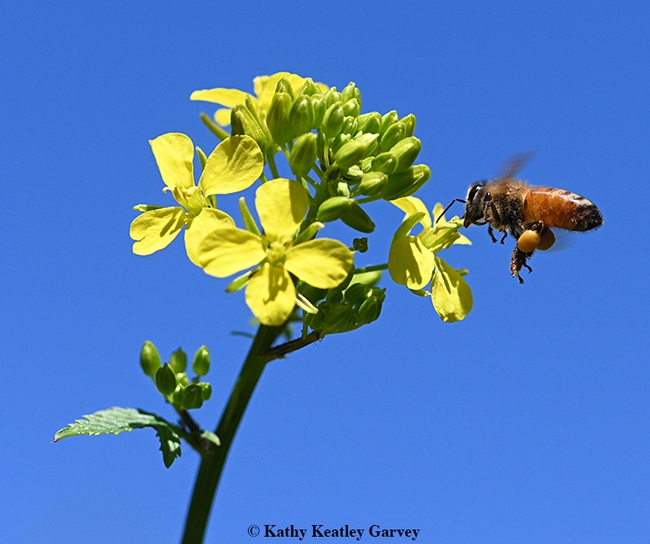
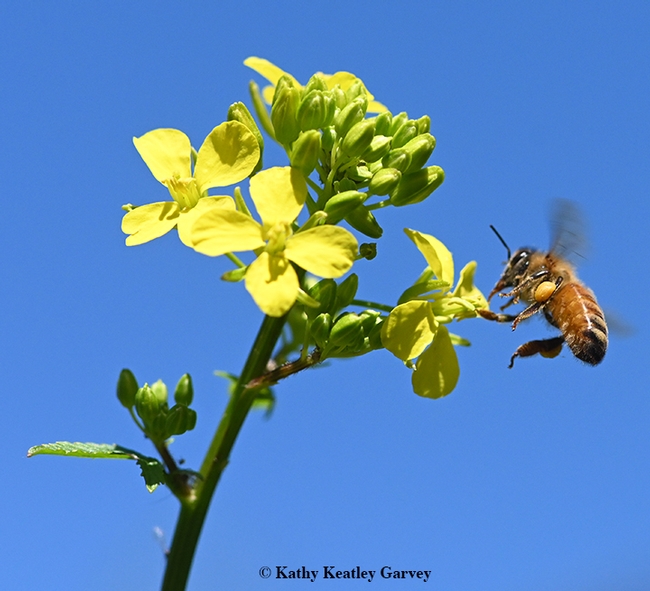
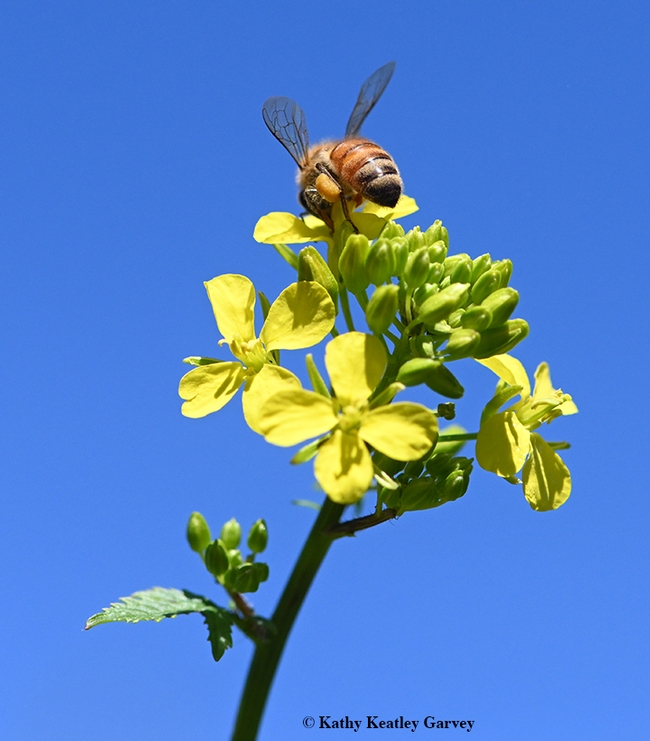
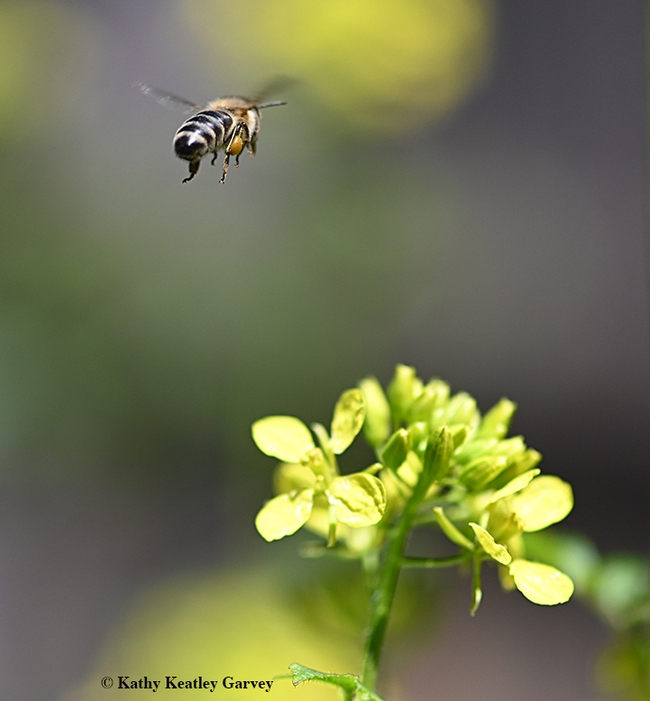
- Author: Kathy Keatley Garvey
The phrase "can't cut the mustard" (not able to handle the job) doesn't apply to honey bees. It's spring and honey bees are emerging en force from their hives to collect nectar and pollen to feed their colonies.
The fields are awash with mustard.
By the way, O. Henry, in his collection of short stories, The Heart of the West, was apparently the first known person to use the phrase, "Cut the mustard." He wrote: "I looked around and found a proposition that exactly cut the mustard."
Today we hear the more negative version, "can't cut the mustard."
Meanwhile, it's a joy to see a bee swathed in gold dust from the mustard. In doing so, our bee is akin to the kid with a milk mustache. Life is good!
"The importance of pollen to the health and vigor of the honey bee colony cannot be overstated," UC Davis emeritus professor and retired bee wrangler Norman Gary writes in the newly published second edition of his book, The Honey Bee Hobbyist: The Care and Keeping of Bees. "Bees need a balanced diet. Honey satisfies the bees' carbohydrate requirements, while all of the other nutrients--minerals, proteins, vitamins and fatty substances--are derived from pollen. Nurse bees consume large amounts of pollen, converting it into nutritious secretions that are fed to developing larvae. During an entire year a typical bee colony gathers and consumes around 71 pounds (35 kg) of pollen."
The next time you see honey bees collecting pollen, think of a colony gathering 71 pounds of pollen a year!
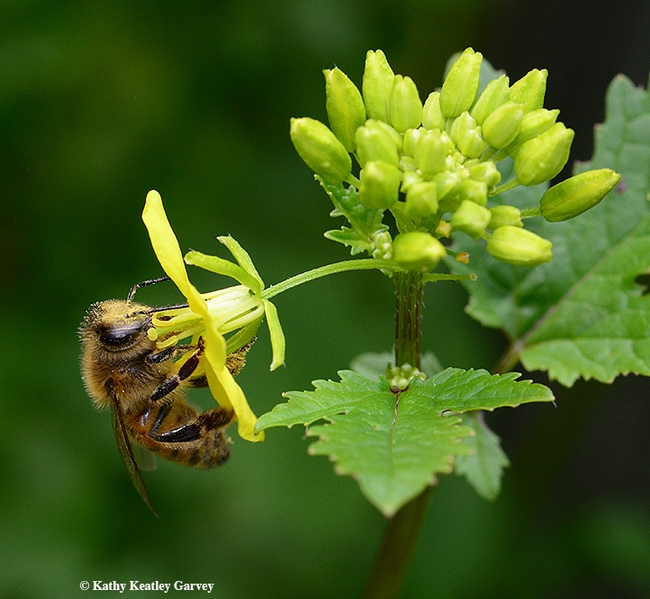
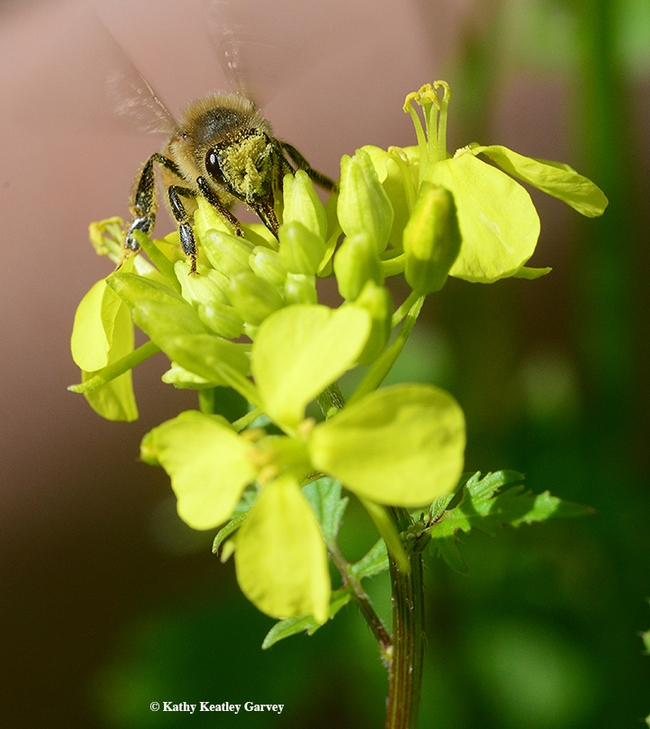
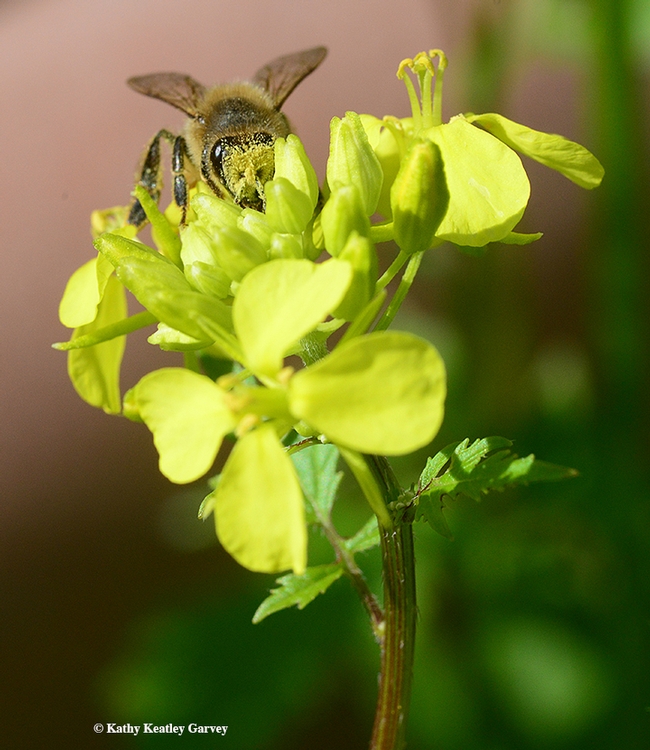
- Author: Kathy Keatley Garvey
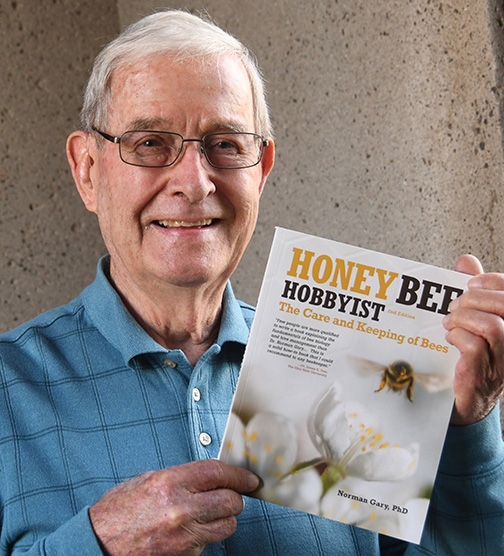
When folks hear about the 70-year beekeeping/bee wrangling career of 85-year-old apiculturist Norman Gary, emeritus professor of entomology at the University of Davis, they ask:
"How many times have you been stung?"
Let's see, can you guess?
Gary, internationally known as "The Bee Man," began keeping bees at age 15 in Florida. His career includes hobby beekeeper, commercial beekeeper, deputy apiary inspector in New York, honey bee research scientist, entomology professor, author, bee wrangler and Guinness World record holder.
He once trained bees to fly into his mouth to collect food from a small sponge saturated with artificial nectar. His holds the Guinness World record (109 bees inside his closed mouth for 10 seconds) for the stunt. He's also the person behind the "bee suit" record in the Guinness World Records; Gary clustered more than 87 pounds of bees on a friend.
So, how many times has he been stung?
"I didn't keep records, of course," the Sacramento-area resident understandably points out. "Many thousands for sure! I was probably stung over a thousand times during one summer as an apiary inspector in New York state. We didn't wear gloves."
"People don't understand that a sting is not very significant if you remove the stinger within several seconds before much venom is injected," he says. "So we worked fast and took chances that resulted in more stings but we didn't mind that much because we developed a strong tolerance, without significant reactions, and removed the stings instantly."
"During my long career, I manipulated much greater numbers of colonies more frequently than most bee researchers because my research was field-oriented. So several hundred stings per year for 70 years is a lot of stings. My guess is that the total number of stings would be around 20,000. Unfortunately the sting number estimates were greatly exaggerated during some of my TV shows. But that is show biz!"
Gary, author of the newly published Honey Bee Hobbyist: The Care and Keeping of Bees, second edition, writes in his book that "most people have an exaggerated sense of dread concerning bee stings due to a wealth of misleading negative information in the media."
Bees are defensive, not aggressive, he says. "Defensive behavior happens only when you are very close to the hive. Bees foraging on flowers or collecting water certainly have the ability to sting, yet they behave as if hey are totally defensiveless. They will fly away in response to the slightest disturbance. Remember, a bee that has stung dies within a few seconds and the colony benefits only if this sacrifice is made in defense of the colony."
Gary, who holds a doctorate in entomology from Cornell University, joined the UC Davis entomology faculty in 1962, retiring in 1994 after a 32-year academic career. He has authored more than 100 publications, including scientific papers, book chapters and popular articles in beekeeping trade journals. During his professional bee wrangling career spanning four decades, “The Bee Man” served as a consultant and bee stunt coordinator for 17 movies, 70 TV shows and six TV commercials. Among his credits: the movie, “Fried Green Tomatoes” and TV appearances with Johnny Carson and Jay Leno.
In his book, Gary covers activities inside and outside the hive, reproduction, management of colonies, honey and other products, urban beekeeping, beekeeper education (he mentions the UC Davis-based California Master Beekeeper Program), and entertaining with bees, among other topics.
That's in addition to colony defense and sting prevention. "The Bee Man" zeroes in on stinging behavior, getting stung, minimizing the effects of stings, reactions to stings, and why bees sting.
Why do they sting? "Defensive behavior is necessary for their survival, to protect the colony and the stored honey and pollen."
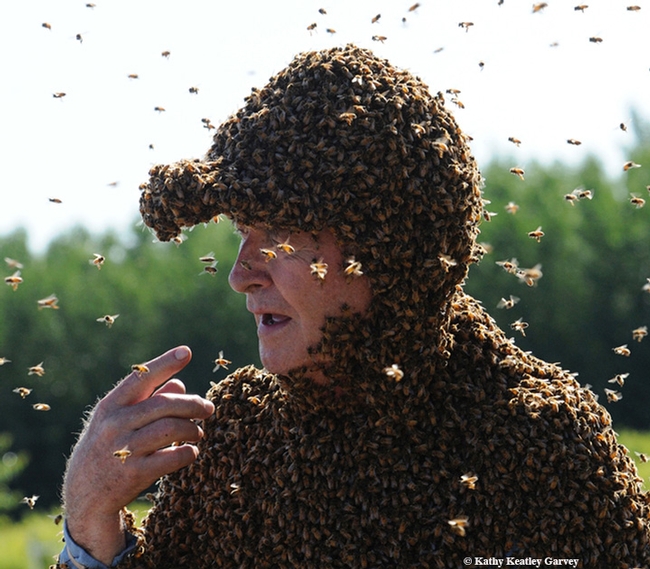
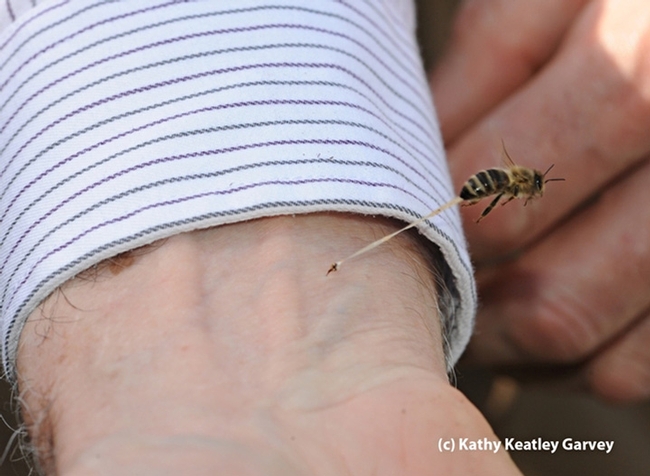
- Author: Kathy Keatley Garvey
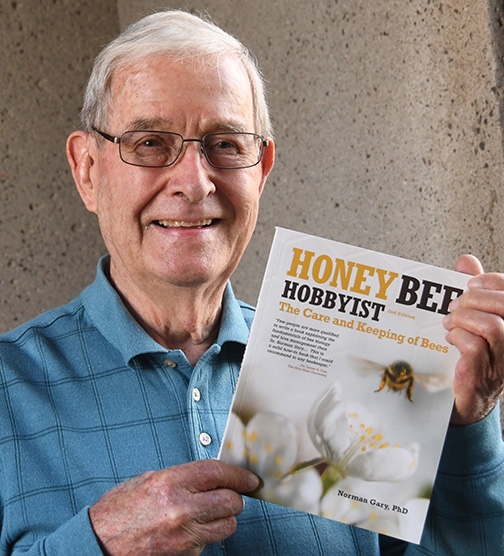
Just as pesticides, parasites, predators, and a multitude of microorganisms threaten the survival of honey bees, so do hobby beekeepers who are rearing too many colonies for bees to “survive and thrive.”
“Increasing populations of bees can easily ‘overgraze' the resources," says Gary, 85, whose expertise in beekeeping, including professor, scientist, author and professional bee wrangler, spans seven decades. "Excessive competition for limited nectar and pollen sources also threatens hundreds of native bee species, such as bumble bees, that have similar dietary requirements.”
He acknowledges that his chapter on Urban Entomology, “treads on sacred beekeeping ground by proposing a radical change to beekeeping in urban environments.”
But it's time “to recognize the realities of the urban environment and make appropriate changes in beekeeping practices,” he declares.
Gary, a Sacramento-area resident known internationally as “The Bee Man” says that urban environments vary greatly, from the heart of New York City or San Francisco where small residential lots typically have limited vegetation to smaller urban areas that that often have “open countryside within the foraging area of your bees.”
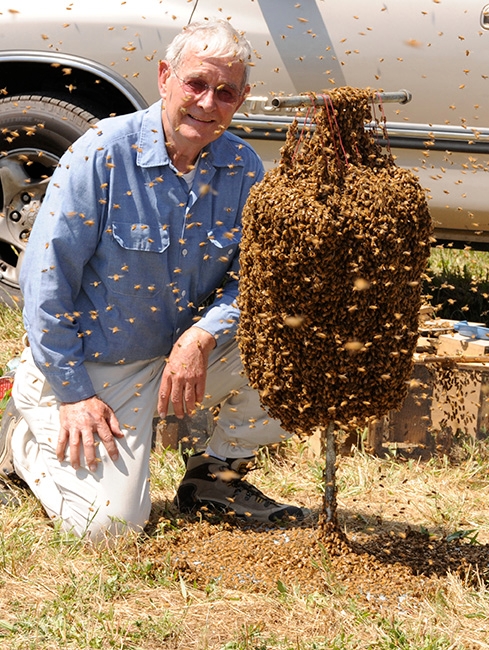
“This is far more than typical hobby beekeepers are harvesting these days,” Gary relates. “It should be obvious that hobby beekeepers are keeping too many colonies in the typical urban environment.”
“Hobby beekeepers typically start out with one or two hives, but that often leads to several more due to their enthusiasm for keeping bees and harvesting more honey and equating the number of hives with elevating their status as beekeepers.”
In his book, published by Fox Chapel Publishing, East Petersburg, Pa., Gary shares his beekeeping knowledge, dispels many beekeeping myths, and provides science-based information. He covers such subjects as “To Beekeep or Not to Beekeep,” “The Bees' Home,” “Reproduction,” “Colony Defense and Sting Prevention” and activities inside and outside the hive.
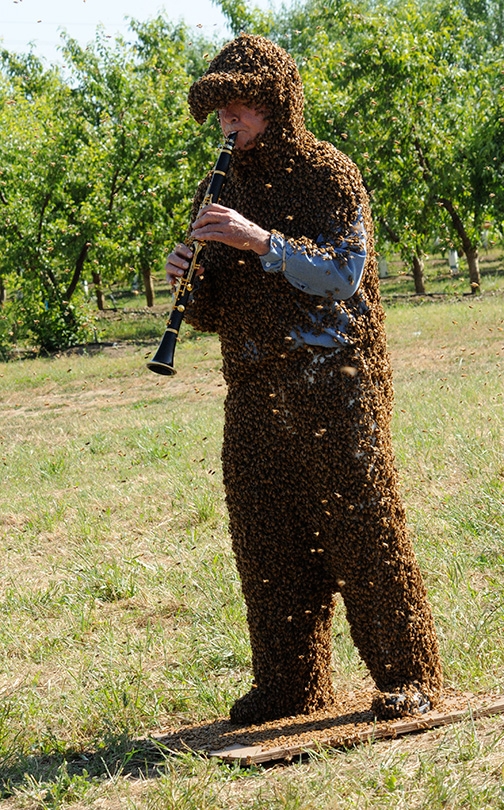
Gary, who holds a doctorate in entomology from Cornell University, joined the UC Davis entomology faculty in 1962, retiring in 1994 after a 32-year academic career. He has authored more than 100 publications, including scientific papers, book chapters and popular articles in beekeeping trade journals.
A 70-year beekeeper--one of the longest in the nation--Gary began keeping bees at age 15 in Florida. His career includes hobby beekeeper, commercial beekeeper, deputy apiary inspector in New York, honey bee research scientist, entomology professor, author, bee wrangler and Guinness World record holder.
During his professional bee wrangler career spanning four decades, “The Bee Man” served as a consultant and bee stunt coordinator for 17 movies, 70 TV shows and six TV commercials. Among his credits: “Fried Green Tomatoes” and appearances with Johnny Carson and Jay Leno on Tonight Shows.
Gary once trained bees to fly into his mouth to collect food from a small sponge saturated with artificial nectar. His holds the Guinness World record (109 bees inside his closed mouth for 10 seconds) for the stunt. He's also the person behind the "bee suit" record in the Guinness World Records; Gary clustered more than 87 pounds of bees on a friend.
Today, as a musician, he plays the clarinet, alto sax, tenor sax, and flute with several groups, and is updating his website, http://www.normangary.com.
No more “Buzzin' with His Bee-Flat Clarinet,” though.
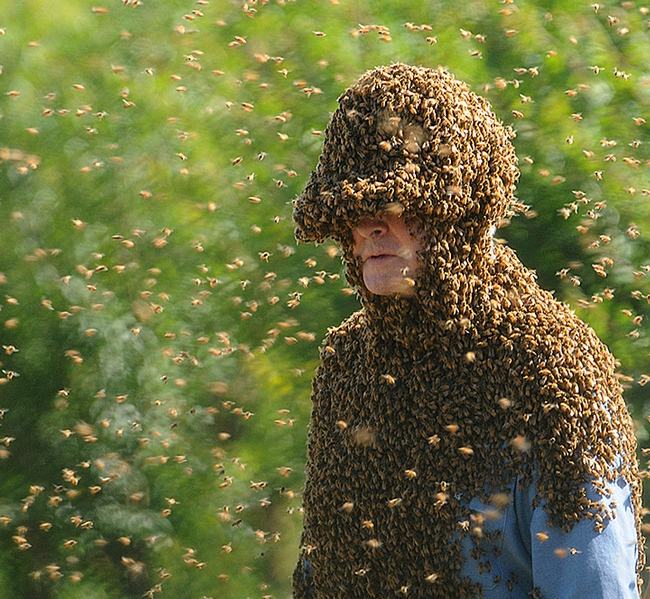
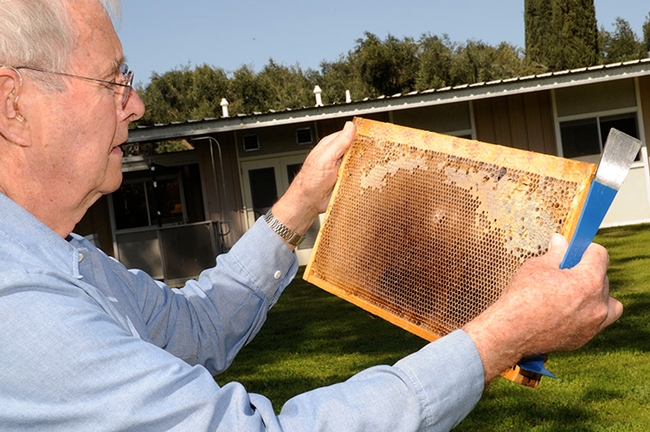
- Author: Kathy Keatley Garvey
Bee-hold, the eye of a honey bee!
Have you ever looked into the eye of a honey bee? Really looked?
If you read Norm Gary's popular book, Honey Bee Hobbyist: The Care and Keeping of Bees, you'll see just how marvelous they are.
Norm Gary, emeritus professor of entomology at UC Davis, and a widely known bee wrangler for Hollywood movies and documentaries (as well as a musician), covers many topics in his book, published in 2010 by Bow-Tie Press.
"Bees have two compound eyes, each composed of thousands of light-sensitive 'micro-eyes' (ommatidae) that are fused together," he writes. "Each ommatidium has a lens and a nerve connection. The ommatidia are connected to collectively generate a mosaic of sensory inputs into the bee's tiny brain, where the signals are integrated into a functional image. Yes, bees can see images--especially flower shapes--as well as colors. They see shorter wavelengths better than humans;ultraviolet is invisible to humans, but bees see it as color. Flowers are exquisitely endowed with nature's ultraviolet artwork, which we visually impaired humans can't enjoy."
Note that "there are three additional simple eyes (ocelli) on top of a bee's head," Gary points out.
We've always been fascinated by the microscopic hairs all over the bee body, from the abdomen to the thorax to the head. The branched hairs on the eyes are clearly visible in this photo, taken with a Canon MPE-65mm lens.
This little bee was foraging in our Spanish lavender, and stopped to "eye" me.
